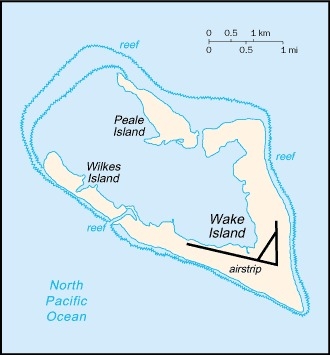Wake Island
Introduction
Background
Wake Island was probably visited by Micronesian and Polynesian settlers, and oral legends tell of periodic voyages to the islands by people from the Marshall Islands. Wake Island was uninhabited when Spanish explorer Alvaro de Mendana de NEYRA became the first European to see it in 1568 and still had no humans when English captain Samuel WAKE sailed by it in 1796. The United States Exploring Expedition visited the island in 1841 and the US annexed it in 1899 to use as a cable and refueling station between its newly acquired Pacific territories of Hawaii and the Philippines and Guam. In the 1930s, Pan-American Airways built facilities on Wake Island so that it could be used as a stopover for flights from the US to China. In January 1941, the US began to install military assets on Wake Island and in early December of that year, Japan attacked Wake Island, capturing it by the end of the month after a heroic resistance. Japan held Wake Island until the end of World War II, and in 1946, commercial airlines once again used Wake Island as a refueling stop.
In 1973, the Marshall Islands claimed Wake Island based on the oral legends, although the US has not recognized these claims. In 1974, the US military took exclusive control of the island’s airstrip and restricted visitors. In 1978, Bikini Islanders from the Marshall Islands, who were evacuated in the 1950s and 1960s because of US nuclear tests, considered rehoming on Wake Island, but the US military rejected that plan. Since the 1970s, the island has been important for missile defense testing. In 2009, Wake Island was included in the Pacific Remote Islands Marine National Monument.
Visit the Definitions and Notes page to view a description of each topic.
Geography
Location
Oceania, atoll in the North Pacific Ocean, about two-thirds of the way from Hawaii to the Northern Mariana Islands
Geographic coordinates
19 17 N, 166 39 E
Map references
Oceania
Area - comparative
about 11 times the size of the National Mall in Washington, DC
Land boundaries
total: 0 km
Coastline
19.3 km
Maritime claims
territorial sea: 12 nm
exclusive economic zone: 200 nm
Climate
tropical
Terrain
atoll of three low coral islands, Peale, Wake, and Wilkes, built up on an underwater volcano; central lagoon is former crater, islands are part of the rim
Elevation
highest point: unnamed location 8 m
lowest point: Pacific Ocean 0 m
Land use
agricultural land: 0% (2018 est.)
other: 100% (2018 est.)
Irrigated land
0 sq km (2012)
Natural hazards
subject to occasional typhoons
Geography - note
strategic location in the North Pacific Ocean; emergency landing location for transpacific flights
People and Society
Population
no indigenous inhabitants (2018 est.)
note: approximately 100 military personnel and civilian contractors maintain and operate the airfield and communications facilities
Age structure
0-14 years: NA
15-24 years: NA
25-54 years: NA
55-64 years: NA
65 years and over: NA
Dependency ratios
total dependency ratio: NA
youth dependency ratio: NA
elderly dependency ratio: NA
potential support ratio: NA
Drinking water source
improved: urban: NA
rural: NA
total: NA
unimproved: urban: NA
rural: NA
total: NA
Environment
Environment - current issues
potable water obtained through a catchment rainwater system and a desalinization plant for brackish ground water; hazardous wastes moved to an accumulation site for storage and eventual transport off site via barge
Climate
tropical
Land use
agricultural land: 0% (2018 est.)
other: 100% (2018 est.)
Government
Country name
conventional long form: none
conventional short form: Wake Island
etymology: although first discovered by British Captain William WAKE in 1792, the island is named after British Captain Samuel WAKE, who rediscovered the island in 1796
Dependency status
unincorporated unorganized territory of the US; administered from Washington, DC, by the Department of the Interior; activities in the atoll are currently conducted by the 11th US Air Force and managed from Pacific Air Force Support Center
Independence
none (territory of the US)
Legal system
US common law
Citizenship
see United States
Flag description
the flag of the US is used
Economy
Economic overview
Economic activity is limited to providing services to military personnel and contractors located on the island. All food and manufactured goods must be imported.
Energy
Electricity access
electrification - total population: 100% (2020)
Communications
Telecommunication systems
general assessment: satellite communications; 2 Defense Switched Network circuits off the Overseas Telephone System (OTS); located in the Hawaii area code - 808 (2018)
Broadcast media
American Armed Forces Radio and Television Service (AFRTS) provides satellite radio/TV broadcasts (2018)
Transportation
Airports - with paved runways
total: 1
2,438 to 3,047 m: 1 (2019)
Ports and terminals
none; two offshore anchorages for large ships
Transportation - note
there are no commercial or civilian flights to and from Wake Island, except in direct support of island missions; emergency landing is available
Military and Security
Military - note
defense is the responsibility of the US; the US Air Force is responsible for overall administration and operation of the island facilities; the launch support facility is administered by the US Missile Defense Agency (MDA)
Transnational Issues
Disputes - international
claimed by Marshall Islands


